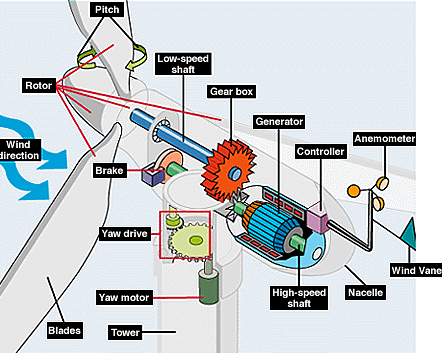wind turbine

Diagram of a typical upwind vertical-axis wind turbine.
A wind turbine is a wind energy conversion device that produces electricity; it typically has one, two, or three blades. Wind turbines can be classified into the vertical axis type and the horizontal axis type. Most modern wind turbines use a horizontal axis configuration with two or three blades, operating either downwind (see downwind wind turbine) or upwind (see upwind wind turbine).
Wind turbines can be used for stand-alone applications, or they can be connected to a utility power grid or even combined with a photovoltaic (solar cell) system, batteries, and diesel generators, called hybrid systems. Stand-alone turbines are typically used for water pumping or communications. However, homeowners and farmers in windy areas can also use turbines to generate electricity. For utility-scale sources of wind energy, a large number of turbines are usually built close together to form a wind farm.
A wind turbine can be designed for a constant speed or variable speed operation. Variable speed wind turbines can produce 8% to 15% more energy output as compared to their constant speed counterparts; however, they necessitate power electronic converters to provide a fixed frequency and fixed voltage power to their loads. Most turbine manufacturers have opted for reduction gears between the low speed turbine rotor and the high speed three-phase generators. Direct drive configuration, where a generator is coupled to the rotor of a wind turbine directly, offers high reliability, low maintenance, and possibly low cost for certain turbines.
Wind turbine components (upwind vertical-axis type)
Anemometer: Measures the wind speed and transmits wind speed data to the controller.
Blades: Most turbines have either two or three blades. Wind blowing over the blades causes the blades to "lift" and rotate.
Brake: A disc brake which can be applied mechanically, electrically, or hydraulically to stop the rotor in emergencies.
Controller: The controller starts up the machine at wind speeds of about 8 to 16 miles per hour (mph) and shuts off the machine at about 65 mph. Turbines cannot operate at wind speeds above about 65 mph because their generators could overheat.
Gear box: Gears connect the low-speed shaft to the high-speed shaft and increase the rotational speeds from about 30 to 60 rotations per minute (rpm) to about 1200 to 1500 rpm, the rotational speed required by most generators to produce electricity. The gear box is a costly (and heavy) part of the wind turbine and engineers are exploring "direct-drive" generators that operate at lower rotational speeds and don't need gear boxes.
Generator: Usually an off-the-shelf induction generator that produces 60-cycle AC electricity.
High-speed shaft: Drives the generator.
Low-speed shaft: The rotor turns the low-speed shaft at about 30 to 60 rotations per minute.
Nacelle: The rotor attaches to the nacelle, which sits atop the tower and includes the gear box, low- and high-speed shafts, generator, controller, and brake. A cover protects the components inside the nacelle. Some nacelles are large enough for a technician to stand inside while working.
Pitch: Blades are turned, or pitched, out of the wind to keep the rotor from turning in winds that are too high or too low to produce electricity.
Rotor: The blades and the hub together are called the rotor.
Tower: Towers are made from tubular steel or steel lattice. Because wind speed increases with height, taller towers enable turbines to capture more energy and generate more electricity.
Wind vane: Measures wind direction and communicates with the yaw drive to orient the turbine properly with respect to the wind.
Yaw drive: Upwind turbines face into the wind; the yaw drive is used to keep the rotor facing into the wind as the wind direction changes. Downwind turbines don't require a yaw drive, the wind blows the rotor downwind.
Yaw motor: Powers the yaw drive.
